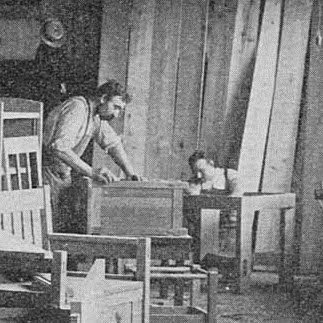Frederick M. Webster
Item
Title
Frederick M. Webster
Date
October 1856 (ca.) to 1924
Description
Frederick M. Webster is documented working for Stickley as early as 1895 and may have been involved in the designing of pieces, based on his later work. Webster’s early career remains obscure, and little is known of him prior to his employment with Stickley. Born in Canada, in October 1856, he immigrated to the United States in 1880. He probably came to Syracuse in 1895—since he does not appear in the city directories prior to this—and was employed as a woodcarver for the Stickley Simonds Company. Following the reorganization of the firm as the Gustave Stickley Company in 1898, Webster was promoted to foreman and served in that capacity from 1899 to 1900. Based on the number of foremen that are recorded in Stickley’s factories at this time, it is likely that the role corresponded to that of department head.
After leaving Stickley, Webster worked briefly with the Sorrento Table Company in Earlville, New York who produced “oak and mahogany jardiniere stands and pedestals, tabourets in a hundred shapes and in a host of attractive designs.” The company was short-lived and their productions are not well known, but they produced at least one table whose floriform design is consonant with the type of tables Stickley made during Webster’s tenure (fig. 2). Webster’s role at the company is not recorded, but he was likely a designer and carver since he left the Sorrento Table Company in 1902 to join the Indian River Chair company in that capacity. Although his career following this is only sporadically recorded, he continued to work as a designer for a chair factory in the 1910 census.
Like Stickley, who returned to Colonial revival designs when the popularity of the Arts and Crafts movement waned in the 1910s, Webster founded the Webster Furniture Company, Inc. in 1920 and specialized in reproductions. An undated catalog from the firm, probably from the 1920s, claimed that “The comfortable Windsor chairs play an important part in contributing to the English atmosphere of hospitality and good cheer.” When he died in 1924, his obituary called him “well known as a furniture man, especially in the field of a design.”
After leaving Stickley, Webster worked briefly with the Sorrento Table Company in Earlville, New York who produced “oak and mahogany jardiniere stands and pedestals, tabourets in a hundred shapes and in a host of attractive designs.” The company was short-lived and their productions are not well known, but they produced at least one table whose floriform design is consonant with the type of tables Stickley made during Webster’s tenure (fig. 2). Webster’s role at the company is not recorded, but he was likely a designer and carver since he left the Sorrento Table Company in 1902 to join the Indian River Chair company in that capacity. Although his career following this is only sporadically recorded, he continued to work as a designer for a chair factory in the 1910 census.
Like Stickley, who returned to Colonial revival designs when the popularity of the Arts and Crafts movement waned in the 1910s, Webster founded the Webster Furniture Company, Inc. in 1920 and specialized in reproductions. An undated catalog from the firm, probably from the 1920s, claimed that “The comfortable Windsor chairs play an important part in contributing to the English atmosphere of hospitality and good cheer.” When he died in 1924, his obituary called him “well known as a furniture man, especially in the field of a design.”

